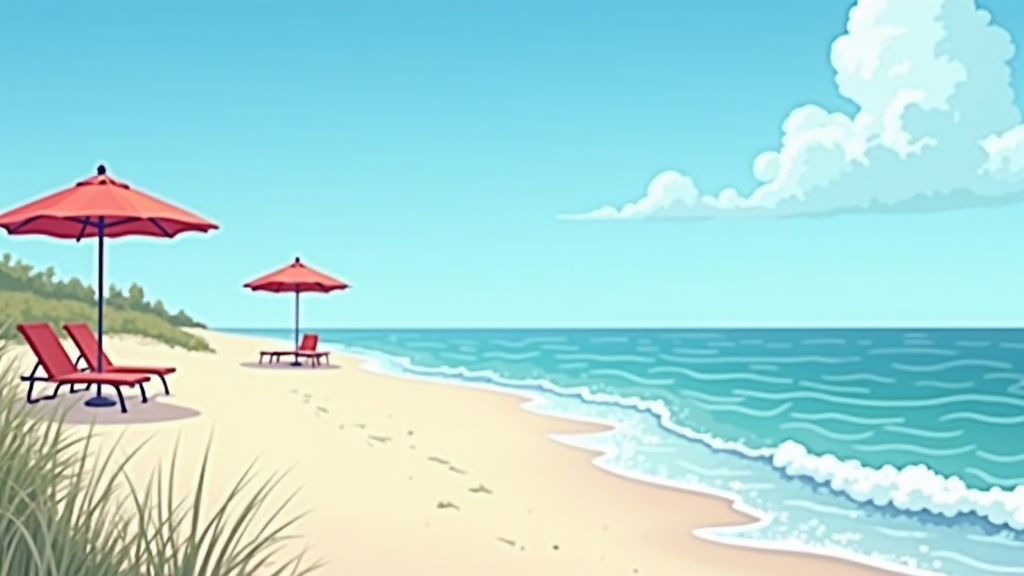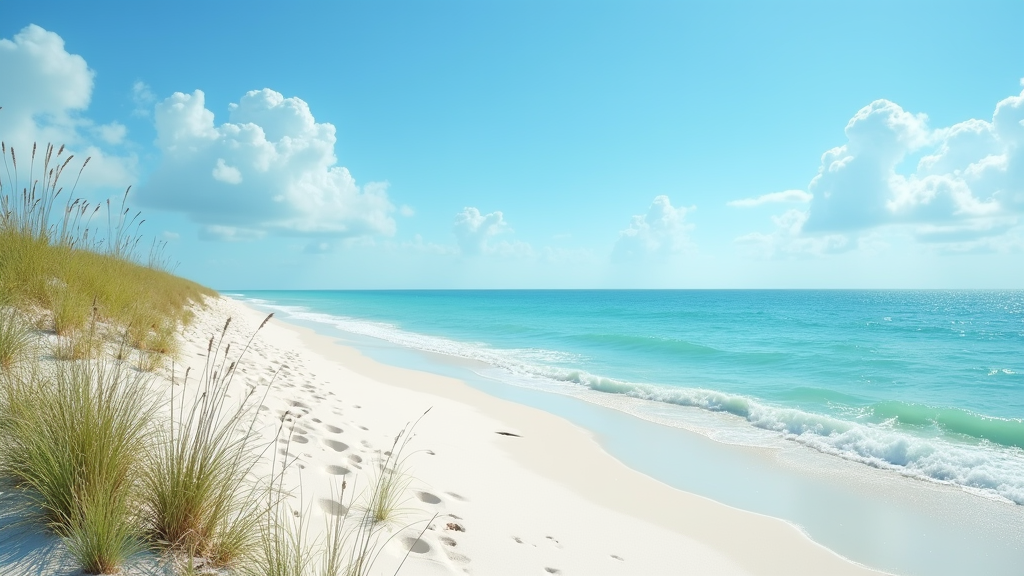Table of Contents
- Exploring the Best Beaches in the Florida Panhandle: An Outline
- Exploring Beaches in the Panhandle of Florida: An Outline
- Detailed Guide: Exploring the Best Beaches in the Panhandle of Florida
Exploring the Best Beaches in the Florida Panhandle: An Outline

Panhandle Beaches: Overview and Why They Matter
The Florida Panhandle is home to approximately 150 miles of breathtaking beaches. These beaches are famous for their incredibly fine, white quartz sand and the clear, emerald-blue/green waters that give the region its “Emerald Coast” moniker. Choosing the right beach can significantly enhance your vacation, making the difference between a good trip and an unforgettable one.
The popularity of the Panhandle beaches is well-documented. Each year, over 10 million tourists flock to this region, contributing over $10 billion to the local economy. This highlights the importance of tourism and the need for resources to help visitors navigate the many options available.
Historical Context and Recent Panhandle Beach Developments
The Florida Panhandle’s history is as rich and diverse as its coastline. From its early inhabitants, including various Native American tribes, to the influence of Spanish explorers and later, American settlers, the area boasts a unique cultural heritage. This history is woven into the landscape, adding depth to the natural beauty of the beaches.
In recent years, the Panhandle has seen increased development aimed at accommodating the growing number of visitors. However, this growth is being carefully balanced with conservation efforts designed to protect the area’s natural resources and preserve its pristine beauty. A particularly notable stretch is the Emerald Coast, which spans 80 miles between Pensacola and Panama City, offering a diverse array of beach experiences.
What You’ll Learn: Mastering Your Panhandle Beach Trip
This guide will provide you with a comprehensive understanding of the unique characteristics of each beach in the Florida Panhandle. You’ll learn to differentiate between beaches based on sand quality, water clarity, available amenities, and overall atmosphere. This knowledge will empower you to make informed decisions and select the perfect beach for your specific needs.
Whether you’re seeking a tranquil escape for relaxation, an action-packed adventure, or a family-friendly destination, this outline will help you find it. We’ll also explore the renowned 30A Highway, a scenic route that connects many of the most popular vacation spots between Destin and Panama City, offering a gateway to some of the Panhandle’s most treasured beaches.
Exploring Beaches in the Panhandle of Florida: An Outline
Fundamental Concepts of Panhandle Florida Beaches
Understanding the basics of Florida Panhandle beaches involves grasping a few key definitions and core principles. The region is renowned for its unique characteristics, and knowing these elements enhances the beach-going experience.
- Quartz Sand:The pristine white beaches are composed primarily of quartz, a form of silicon dioxide. This composition gives the sand its brilliant, reflective color and soft texture.
- Emerald Coast:The Florida Panhandle is often called the “Emerald Coast” because of the stunning green hue of its waters. This vibrant color is due to a combination of factors, including water currents and the presence of algae.
Several factors influence the overall quality of a beach. These include the composition of the sand, the clarity of the water, how easy it is to get to the beach, and the available amenities.
Essential Components Defining Panhandle Florida Beaches
Several essential components define the beaches in the Florida Panhandle, setting them apart from other coastal destinations. These elements contribute to the area’s unique appeal and popularity.
- Fine, White Sand:The signature feature of these beaches is the incredibly fine, white sand. This sand is soft to the touch and stays relatively cool even in the hot sun, making it ideal for walking and relaxing.
- Clear, Emerald-Green Water:The crystal-clear, emerald-green water is another defining characteristic. This inviting water is perfect for swimming, snorkeling, and other water activities.
When considering a visit to a Panhandle beach, several key features should be taken into account:
- Accessibility:How easy is it to get to the beach? Consider parking availability and proximity to nearby amenities.
- Amenities:Are there restrooms, showers, and restaurants available? What about recreational activities like water sports rentals?
- Crowds:How crowded is the beach, especially during peak season? If you prefer a more secluded experience, consider visiting during the off-season or exploring less popular beaches.
The quality of a beach can be evaluated based on both primary and secondary aspects.
- Primary Aspects:These include the quality of the sand, the clarity of the water, and safety measures such as the presence of lifeguards.
- Secondary Aspects:These include nearby attractions, dining options, and shopping opportunities.
Finally, it’s important to consider the variations between different types of beaches. Some beaches are surrounded by beachfront developments, while others are part of natural preserves. This can significantly impact the overall experience.
Detailed Guide: Exploring the Best Beaches in the Panhandle of Florida

* **Explore diverse beaches:** Discover the perfect beach for your preferences, from lively Panama City Beach to tranquil spots like St. Joseph Peninsula State Park.
* **Enhance your experience:** Use online resources for optimal timing and explore lesser-known beaches for a secluded, nature-filled getaway.
Essential Preparation for Visiting Panhandle Florida Beaches
Before you head out to enjoy the stunning beaches of the Florida Panhandle, it’s crucial to be well-prepared. This ensures a safe, comfortable, and enjoyable experience.
- Required Materials:Make sure to pack essentials such as sunscreen (SPF 30+ recommended) to protect your skin from the strong sun, a large beach towel for relaxation, an umbrella for shade, a cooler stocked with drinks and snacks to stay hydrated and energized, and comfortable beach chairs.
- Initial Setup:Always check the weather forecast and tide charts before heading to the beach. This will help you avoid unexpected weather changes and plan your activities around the tides.
- Important Considerations:Be aware of local regulations regarding alcohol consumption, pet policies, and beach fires. Following these rules helps maintain the cleanliness and safety of the beaches for everyone.
Step-by-Step Guide: Finding Your Perfect Florida Panhandle Beach
The Florida Panhandle boasts a diverse range of beaches, each with its unique charm and appeal. This guide will help you discover the perfect beach to suit your preferences.
- Step 1: Panama City Beach:Enjoy 27 miles of white quartz sandy beaches perfect for swimming, snorkeling, diving, kayaking, fishing, and sunset boat tours. Explore secluded spots like Shell Island and nearby Mexico Beach. Don’t miss the wildlife viewing opportunities at St. Andrews State Park.
- Step 2: Santa Rosa Beach:Discover pristine sugary white sand beaches and turquoise waters. Visit nearby Topsail Hill Preserve State Park for hiking, biking, and birdwatching. Enjoy the secluded white sandy beaches perfect for relaxation.
- Step 3: Fort Walton Beach:A family-friendly beach town with diverse attractions including parks, museums, and an aquarium. Offers calm waters and powdery sands ideal for beach activities.
- Step 4: Destin:Known as “The World’s Luckiest Fishing Village,” Destin features emerald waters, sugar-white sands, and excellent fishing opportunities. Explore nearby Henderson State Park, which offers 6,000 feet of natural shoreline.
- Step 5: Pensacola Beach:Famous for its emerald-green waters and sugar-white sands. Enjoy strolling along the Pensacola Beach Pier, snorkeling, and sunset viewing. This beach is consistently ranked as one of the top beaches in Florida.
- Step 6: Seaside:Famous for its charming setting, as seen in “The Truman Show.” Features quaint pastel-colored houses and no cars on the streets, making it ideal for a family getaway.
- Step 7: Seagrove Beach:A small, tranquil beach known for its natural canopy, offering solitude and peacefulness.
- Step 8: Grayton Beach:Known for its one-mile shoreline and clear emerald-green waters. Offers nature trails, kayaking at nearby Western Lake, and scenic 4-mile bike trails through pine flatwoods.
- Step 9: St. Joseph Peninsula State Park:Offers 9.5 miles of serene, unspoiled, snow-white sand beaches. St. Joseph Bay is ideal for fishing or swimming. Visit nearby Cape San Blas beach for its picturesque views.
- Step 10: St. George Island State Park:Features powdery white beaches with miles of unspoiled natural beauty. Enjoy swimming, sunbathing, canoeing, hiking, and fishing. Explore nearby Dog Island for further adventure.
- Step 11: Navarre Beach (Cape San Blas area):Known for its luxurious 12-mile shoreline, perfect for solitude. Enjoy swimming, biking, and exploring Gulf Islands National Seashore.
- Step 12: Perdido Key State Park:Offers rolling white-sand dunes and warm waters. Includes access to Big Lagoon State Park for camping and hiking opportunities.
- Step 13: Blue Mountain Beach:Known for its soft white sands and natural beauty. Ideal for relaxation and outdoor activities such as swimming, kayaking, and biking. Close to excellent Gulf seafood restaurants.
Best practices: Arrive early to secure a good spot, stay hydrated by drinking plenty of water, and be mindful of the environment by properly disposing of trash and avoiding disturbing wildlife.
Common mistakes to avoid: Forgetting sunscreen, ignoring warning flags indicating hazardous water conditions, and leaving trash behind, which can harm the environment and detract from the beauty of the beaches.
Advanced Techniques for Florida Panhandle Beach Enthusiasts
Take your beach experience to the next level with these expert tips and techniques for exploring the Florida Panhandle’s coastline.
- Expert Tips:Explore lesser-known beaches for a more secluded experience, such as those along the scenic 30A highway. These hidden gems offer a quieter and more intimate connection with nature.
- Optimization Methods:Use online resources like beach condition reports and tide charts to plan your visit. These tools provide valuable information about water quality, wave conditions, and optimal times for swimming and other activities.
- Troubleshooting:If the beach is too crowded, consider visiting during the off-season or exploring nearby state parks. These alternatives offer a more relaxed and less congested environment, allowing you to fully appreciate the natural beauty of the area.


